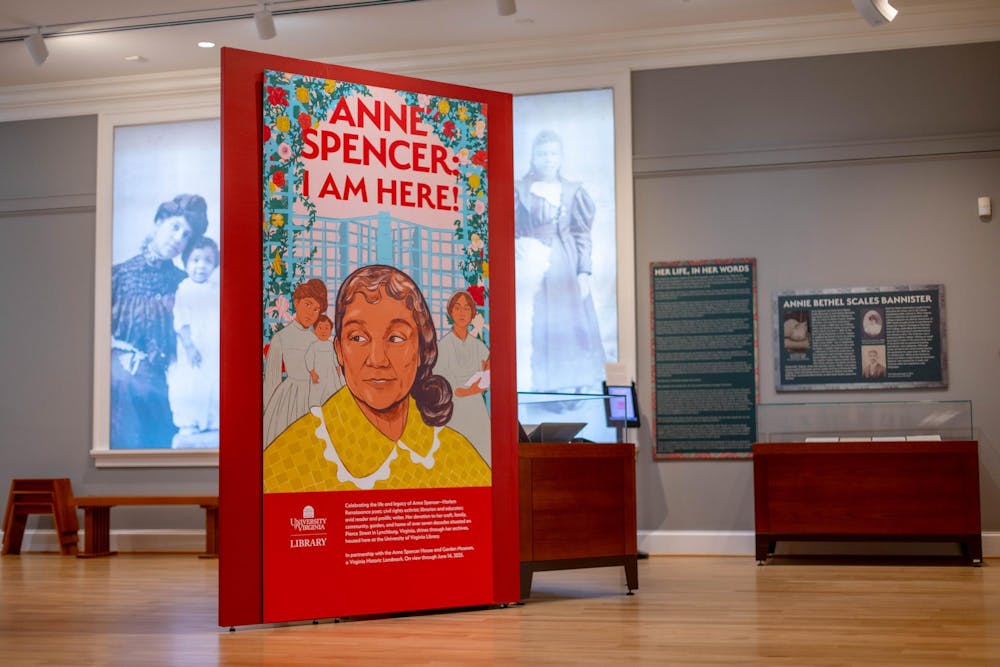The “Anne Spencer: I Am Here!” exhibition at the Albert and Shirley Small Special Collections Library honors Harlem Renaissance poet and Civil Rights activist Anne Spencer. Located in the library’s Main Gallery, the exhibition opened Oct. 22 and will run through June 14.
Anne Spencer was born near Danville, Virginia, in 1882. She moved to Lynchburg as a child where she spent the rest of her life, eventually becoming a central figure in Lynchburg’s intellectual and political circles.
The exhibition showcases Spencer’s personal effects, including diaries, original poems and letters, to highlight her poetry and prose. Other parts of the exhibit, such as biography excerpts, explain her relationship to Lynchburg’s Civil Rights movement — she helped develop a constitution for the Lynchburg branch of the NAACP after becoming a member of the organization in 1912.
Exhibitions Coordinator Jacquelyn Kim, who helped curate the portion on Spencer’s Civil Rights involvement, explained why it was important that the exhibition presented the different aspects of Spencer’s life.
“She really was so multifaceted, and this exhibit is really trying to highlight all these different spheres of her life that were important to her and that she really worked to cultivate,” Kim said.
To display both Spencer’s literary and political work, the exhibition utilizes several freestanding displays. In the shape of a cube, each display imparts information about a specific part of Spencer’s life, such as her poetry, time as a school librarian, involvement in the Lynchburg chapter of the NAACP and fondness for her garden or home. Viewers can walk around all four sides of each cube and read the information as well as view placards, photographs and artifacts from various aspects of Spencer’s life.
Much of Spencer’s prominent work started from within her Lynchburg home. There, Spencer wrote poems on the walls and scraps of papers and avidly kept a garden, which inspired her poetry many times. Interestingly, she even wrote notes on a packet of seeds, which is on display at the exhibit.
Spencer’s home was a center for political conversation, something which the exhibition highlights. In a section called “Anne Spencer’s Social Network,” the 16 Civil Rights intellectuals who Spencer hosted in her Lynchburg home are discussed. Among the figures are W.E.B. Du Bois, Thurgood Marshall, Langston Hughes and James Weldon Johnson. During Johnson and Hughes’ visits, they noticed Spencer’s writing around her home and encouraged her to pursue poetry writing seriously. Over time, these figures brought ideas from the Harlem Renaissance to Lynchburg, and while Spencer was influenced by these ideas, she also developed a distinct writing style.
Alison Booth, English professor and the curator of the poetry section of the exhibit, spoke on the variability between Harlem Renaissance writers. Some were deeply concerned with capturing African American artistry after enslavement, and some, like Spencer, wrote about race in a less obvious way according to Booth.
“Spencer herself kept saying, ‘I'm a Black woman. I write who I am. I'm proud to be a Black woman.’ She's not trying to camouflage herself in any way, but she doesn't think she has to write about race every time she puts pen to paper,’” Booth said. “She's writing about being a Black woman in all of her poems, without it being the topic.”
Booth labeled Spencer’s type of poetry as what she calls “sustainable poetry” — poetry that believes that the Earth’s natural components are like God and that the natural world is the center of the universe, not humanity.
This idea of sustainability is evident within the exhibit. In fact, the portion of the exhibit’s title “I Am Here!” is taken from Spencer’s poem “[Earth, I thank you]” in which she thanks the Earth for all its joys while also recognizing the trouble it gave her. The poem ends with the exhibit’s namesake — “I am here!”
“I think it's a timeless declaring of human consciousness. So, ‘I am here’ is always true,” Booth said. “That's what sustainable poetry does, it helps put a little … stake in the ground. Because [Spencer] says, ‘I'm going to get out of the Earth something that is being.’”
As Spencer was concerned with sustainability in her poetry, she also worked hard to form a sustainable community for Lynchburg’s Black residents, specifically through her work as a member of the NAACP. Exhibit-goers can see artifacts of Spencer’s activism, including a receipt for NAACP membership dues or written campaigns to hire Black teachers at Dunbar High School, where she was a librarian.
The exhibit supplements these artifacts with placards expanding on Spencer’s everyday activism. For example, a typescript of Spencer’s poem “Neighbors” is displayed — the placard explains it was written in response to backlash for refusing to ride segregated public transportation, choosing instead to hitch rides on grocery wagons.
Kim noted that Spencer’s coverage of a variety of political topics — from wars in foreign countries to Congressional bills — manifested in her poetry because of her keen eye for detail.
“She's very clearly paying attention to what's happening around her … and drawing connections between radical struggles and people organizing for their rights,” Kim said.
By putting such a wide breadth of information — from activism to poetry — on display, the “Anne Spencer: I Am Here!” explores the Black experience through the lens of a multifaceted woman who took pride in writing and serving her community.
The exhibition concludes a triptych of exhibitions on Black history in Central Virginia, following earlier ones on the Holsinger Picture Studio and the Harlem Renaissance. “Anne Spencer: I Am Here!” will be on display until June 14 in the Special Collections Library’s Main Gallery.
Ultimately, the exhibit serves as an act of remembrance which affirms the importance of reading and remembering Spencer’s work.
“We need to help sustain her poetry. Her poetry is alive now, but only if we make it. We sustain the poets we read. It’s a reciprocity thing,” Booth said.







